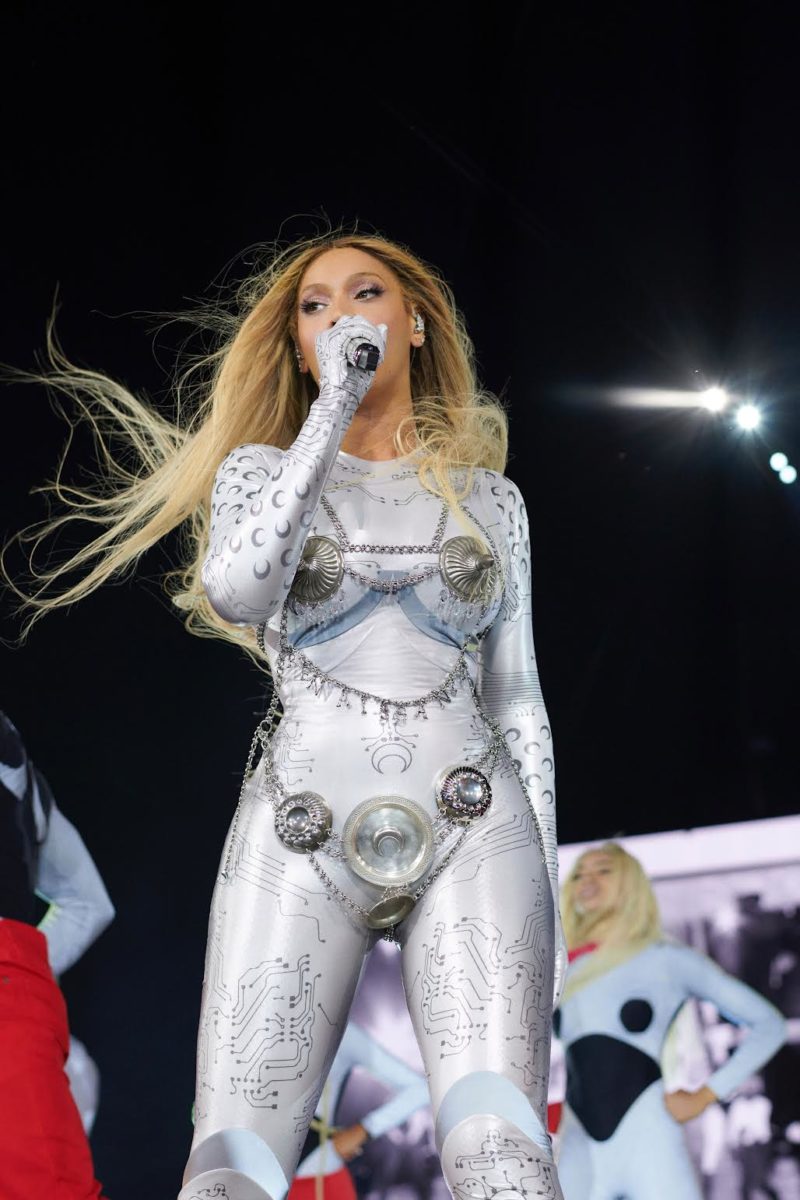Anomalous visuals. Breathtaking vocals. Words alone are not enough to describe the spectacle that Beyoncé prepared for her fans as a part of the Renaissance World Tour. On July 22, the BeyHive gathered at Soldier Field for Beyoncé’s first tour in seven years. A concertgoer next to me summarized it best: “I am so excited to see her again, it has been too long.” Yes, it has. The queen’s highly anticipated return is here.
Seeing Beyoncé in person is akin to a religious experience, and one doesn’t want to miss a single second of her nearly three-hour set. The queen has no openers, so it is crucial to be there very early to get into the stadium on time. I arrived at the field an hour before stage time, but the massive swarm of fans meant that it took about 45 minutes to make my way to my seat in the lower bowl of the stadium.
It’s Beyoncé, so I was prepared for anything…at least I thought I was…until a stadium employee waved me down and asked, “Would you like to sit on stage?” My answer was quickly and obviously a “yes, please!” Thanking my good luck, and the kind woman who gave me my new ticket, I made my way down to the risers on the right side of the stage and discovered I would get to watch the show a mere 10 feet away from where Beyoncé would be performing.
The Renaissance set usually lasts about two and a half hours, which is divided into six distinct acts. For the most part, the show follows her latest album, the eponymous Renaissance, with the songs in sequential order, speckled with her earlier hits like “Formation” and “Crazy in Love.” It is clear that this album is a love letter to her fans, as well as a tribute to the LGBTQ+ influences that were the root of dance music in the 1970s. Beyoncé used Renaissance as a tool to elevate traditionally marginalized groups through collaboration with many queer artists including Big Freedia and Honey Dijon.
The show began an hour late, but I believe that was most likely because fans were still flooding through the gates at the scheduled set time. By the time pale pink clouds floated onto the screen and a glitching retro sign rose to form the image of Beyoncé, the audience was already buzzing with anticipation. Beyoncé emerged, looking heavenly as ever, and the crowd went wild. She wore a breathtaking black ball gown fringed with white feathers, a clear nod to her angelic vocals.
Bey is the queen of the music industry for a reason: her bewitching vocals. She successfully captivated the entire audience as she serenaded the audience with R&B ballads from her early discography atop a shiny, silver piano. Within a few songs, I was converted from casual listener to a member of the BeyHive.
Between acts, the large screen onstage featured videos that alluded to the themes of the next acts. One interlude between a costume change included a maximalist, robot-themed video collage. Another interlude featured live clips of the audience interspersed between clips of queens voguing during a ballroom battle.
Beyoncé performed her electric hits “I’m That Girl” and “Alien Superstar” and danced between two giant mechanical arms affixed to silver picture frames. This was only the beginning of the show’s innovative and endlessly entertaining use of stage props, which was representative of Beyoncé’s attention to detail. Although a ticket to see Beyoncé can be a bit pricey, I came to realize that the cost was justified. It was obvious that she spared no expense on set design and props, making sure that fans had a fantastic view regardless of where they were in the stadium.
The mind control act was designed to look like a satirical news broadcast “KNTY 4 NEWS.” Beyoncé, dressed in a bee-like costume, performed her songs “America Has a Problem” and “Pure/Honey.” During the outro of “Pure/Honey,” Beyoncé exited the stage, giving the spotlight to her dancers as they vogued in a ballroom battle. This segment of the show was by far my favorite for the unparalleled talent and energy of the dancers. Everyone in the stadium went berserk as we watched Miss Honey Balenciaga hit death drops and duck walk to the beat.
One of the most important features of the album Renaissance is its many callbacks to ballroom culture. Ballroom culture, also known as “ball culture”, describes the queer subculture in which walking, modeling, and lip-synching is used as a medium of creativity and expression for many Black and Latino members of the LGBTQ+ community. This album played a big role in bringing ballroom and drag cultures to a mainstream audience, while paying homage to the pioneers of the artforms for being “originators of culture” as stated by Beyoncé on her website.
Beyoncé returned to the stage atop a giant crystal horse mannequin to perform “Summer Renaissance” as an encore. In typical Beyoncé fashion, the horse was attached to a harness and lifted into the air. She performed the album’s namesake song as she flew around the stadium fifty feet in the air. Silver confetti rained down onto the crowd as we all screamed the words to this final song of the night.
Before I knew it, the show was over. I was so transfixed by the performance that three hours had flown by. Beyoncé put on a mind-blowing show that celebrated the unheralded pioneers of house music and ball culture: Black, queer, and trans artists. Beyoncé is truly a world-class artist whose otherworldly vocals and visuals cement her position as one of the greatest performers of all time.









